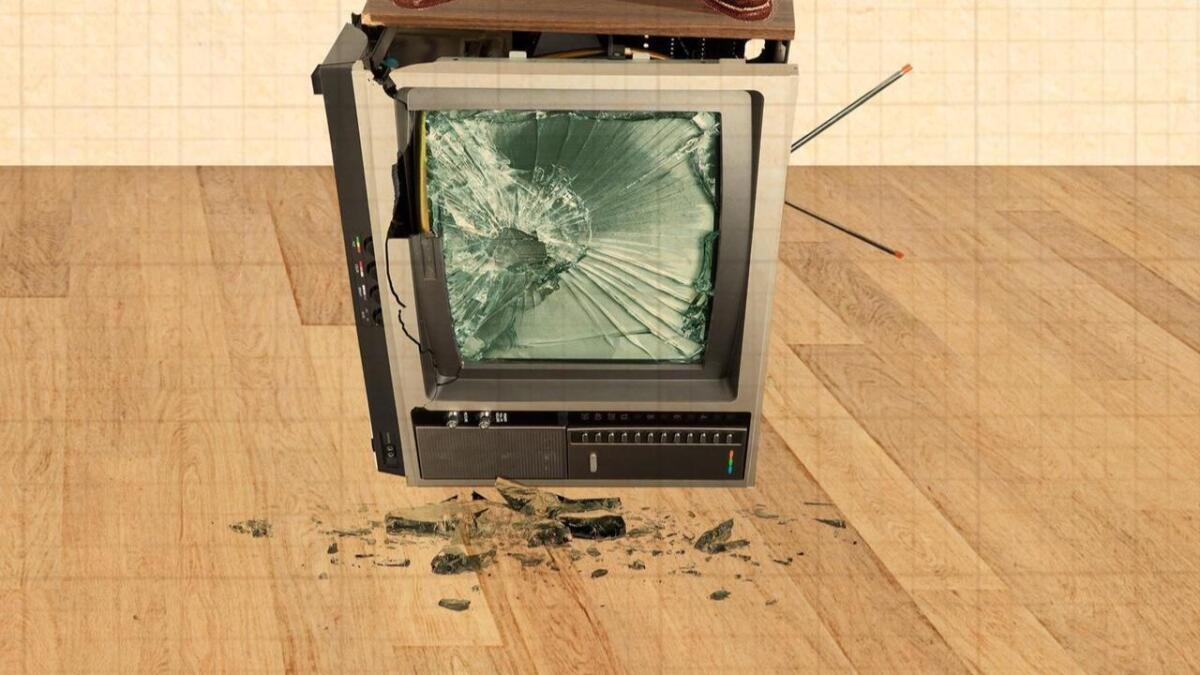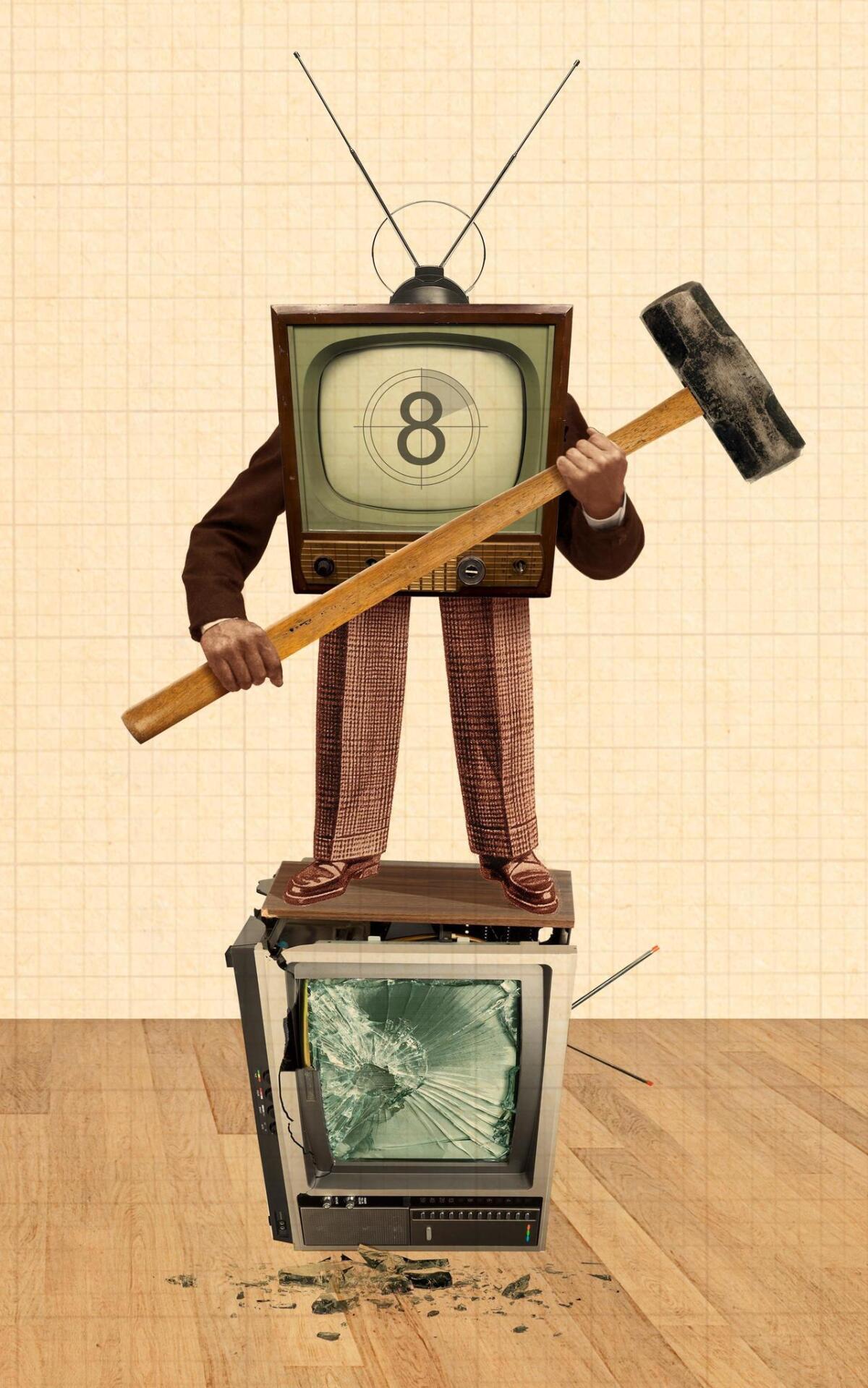Is this the year that TV broke TV? The great fragmentation and why peak TV didn’t die

- Share via
The flat screen on your living room wall, the cable box below it and that digital program guide that help you find your way through an increasingly congested universe of shopping networks, reality show repeats and the eight channels you actually watch might as well have been inhabitants of a dying star in 2018.
Television, already bursting at the seams with peak programming and lots of filler, finally blew apart this year, fragmenting into a dizzying constellation of nearly 500 new original series and destinations we’ve yet to explore (the forthcoming launch of subscription streaming services from Apple, Warner Media, Disney and, yes, Costco and Walmart), plus a whole lot of space debris that includes “Terrence Howard’s Fright Club,” a Fox Nation cooking show and 98% of the offerings on YouTube TV.
A record 495 original scripted series dropped this year, and for the first time, streaming platforms such as Hulu and Amazon Prime delivered more original series programming than broadcast and cable networks.

Forget arguments about when and how peak TV will peak. Judging from the last 12 months, it doesn’t appear we’re anywhere close to the summit. More interesting is what’s been happening below those lofty heights. After a decade or more of seismic shifts across the industry, 2018 became the year television broke TV. The very structure of the medium morphed and changed so rapidly over the last year that we still haven’t wrapped our heads — or attention spans — around exactly what it is we’re watching.
Was the YouTube live stream of Beyoncé’s performance at the Coachella Valley Music and Arts Festival a TV event or something else? And what about the wonderfully bizarre formatting of “Atlanta’s” second season? It was shown on FX, but the series’ self-contained episodes resembled nothing else on TV.
The fragmentation of America’s most popular medium seemed to fit the popular mood — excitement and confusion as the usual order lapsed into unprecedented chaos. A record number of viewers became cord cutters in 2018. From July to September, 1.1 million subscribers opted to sever ties with their longtime cable and satellite TV providers for the cheaper subscription models offered by Netflix, Apple TV, Sling TV and many more. It was one more way in which viewing habits and industry norms were upended in such a dramatic fashion that it made the premium cable revolution of the early 2000s look quaint.
Television, already bursting at the seams with peak programming and lots of filler, finally blew apart this year, fragmenting into a dizzying constellation.
The flood of fresh content and platforms in 2018 didn’t necessarily equal a drop in quality, though it arrived with the usual complaints that this year could never top the one before it: “Killing Eve” is no match for “The Handmaid’s Tale’s” first season. There were so many must-see shows that it was physically impossible to watch them all and live a life outside the confines of pajamas, unless you possessed the combined powers and stamina of Jessica Jones, Daenerys Targaryen and Ruth Bader Ginsburg.
And when it came time to honor TV’s top-shelf entertainment at the Emmy Awards, the usual recipients faced some firsts of their own. It was Netflix, not NBC or FX, that tied HBO for the most wins, ending a winning streak for the cable network that dated back nearly two decades to the golden age of “The Sopranos.”
What’s next
2019 is already shaping up to be a battle between media giants for control of wherever it is that we’re heading. Apple will compete with Netflix by spending way more than it should on originals by big-name producers such as J.J. Abrams and top-tier stars like Reese Witherspoon and Jennifer Aniston. Netflix has a plan of its own and it involves pricey production deals with Ryan Murphy, Shonda Rhimes and the former leading couple of the free world, Michelle and Barack Obama.
CBS All Access, which already has half a dozen original series, including “The Good Fight” and “Star Trek: Discovery” on the streaming platform, is going big in 2019 with a “Twilight Zone” reboot executive produced by Oscar winner Jordan Peele, who will also narrate and host. A big budget, live-action “Star Wars” series starring Diego Luna is expected to launch Disney+ into the stratosphere.
And we haven’t even began sorting through what’s on the books for the networks and services we’re already watching. Expect lots of reality show reboots, the return of water cooler shows like “Game of Thrones” and “Stranger Things,” and the prospect of never feeling caught up with what TV has to offer.
Best of 2018: A look back at the year in movies, TV, music and more »
At least 2018 did away with any residual guilt that may have existed about watching too much television. It was replaced by a solider-like duty to consume as many premium shows as possible or risk being called out by one’s peers: Have you watched “The Little Drummer Girl” yet? How about “Succession”? Not even “The Great British Baking Show”?! Oh, the shame of taking time out for career, family, grooming and sleep. We’ll all have to work on that in 2019.
We have an excuse, though. Half of the year was spent trying to find all those weird little networks and services — Ovation, Britbox, Acorn — and the search required at least three different remotes and three failed password-recovery attempts. Sorry, you’ve been locked out.
Network telecasts still boast the highest ratings, according to Nielsen, and football was at the top of 2018’s most-watched list, followed by the short-lived “Roseanne” reboot. But that’s likely the next convention to be broken by the great fragmentation, especially given that this was the year that an estimated 147.5 million people in the U.S. watched Netflix at least once a month, followed by Amazon Prime Video (88.7 million), Hulu (55 million) and HBO Now (17.1 million).
Netflix hopes to kill off that old ratings standard by introducing more and more original series and films, an approach that “Saturday Night Live” recently satirized in a fake ad for the streaming service. The breathless “commercial” promised a new year with even more content to choose from.
“That’s right, we’re spending billions of dollars and making every show in the world. Our goal is the endless scroll. By the time you reach the bottom of our menu, there’s new shows at the top. And then singularity will be achieved.”
A joke that makes perfect sense in the fragmented universe of post-everything TV.
ALSO
In the crosshairs of outrage: Roseanne, Kathy Griffin and now Kevin Hart. Comedy’s shifting red line
Why the ‘P’ word — propaganda — might be best for what we’re seeing on our TV screens
Trump turns his news conference into a post-election spectacle
The rise and fall of Megyn Kelly and what it says about the state of the media
More to Read
The complete guide to home viewing
Get Screen Gab for everything about the TV shows and streaming movies everyone’s talking about.
You may occasionally receive promotional content from the Los Angeles Times.







